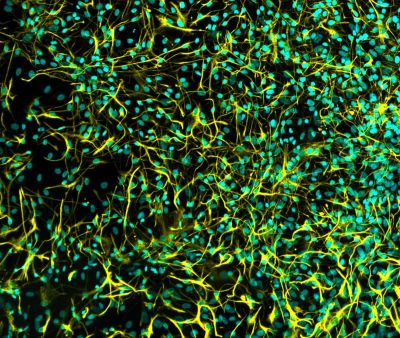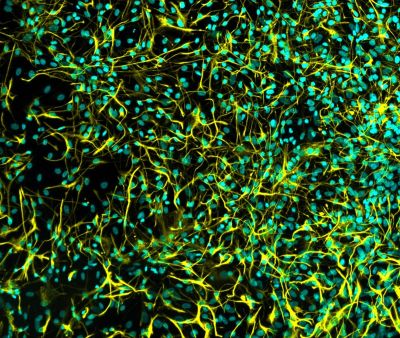Quick-Glia™ Astrocytes - Human iPSC-derived Astrocytes Fatty Liver Disease - (M, 36yr, Asian)
| Short Description | Cryopreserved human iPSC-derived astrocytes from Fatty Liver Disease patient (M, 36) |
|---|---|
| Product Components | Cryopreserved cells and Component P |
| Starting Material | iPSCs derived from peripheral blood mononuclear cells (CIRM line CW10130) |
| Product Use | This product is for research use only. It is not approved for use in humans or for therapeutic or diagnostic use. |
| Storage Conditions | Frozen cells should be stored in liquid (vapor phase). The rest of the components should be stored at -20°C. |
| Cell Type | Astrocytes |
| Culture Type | Feeder Cell-Free |
| Disease | Fatty Liver Disease |
| Donor Sex | Male |
| Donor Race Ethnicity | Asian |
| Patient History | See Resources section for more information. |
| Reprogramming Method | Episomal vector |
| Induction Method | Transcription factors delivered by Sendai virus |
| Growth Properties | Adherent |
| Shipping Conditions | Dry ice (domestic) or liquid nitrogen (international) |
| Shelf Life | 1 year |
| Donor Age At Sampling | 36 |
iPS細胞のドナー情報
Donor data for CIRM line: CW10130
ポスター
Functional and pharmacological evaluation of iPSC-derived astrocytes generated by a rapid differentiation method (Society for Neuroscience 2022)
Functional evaluation of iPSC-derived astrocytes generated by a rapid differentiation method (Neuro2022 in Japan)
Using Human iPSC-derived Neurons and Astrocytes Produced by Transcription Factor-Based Differentiation Protocols to Generate Models to study Alzheimer’s Disease in vitro (Society for Neuroscience 2022)
Generation of Alzheimer’s Disease Model Using Human iPSC-derived Neurons and Astrocytes Produced by a Transcription Factor-Based Differentiation Protocol (Neuro4D 2022)
エリクサジェン・サイエンティフィック社が販売するヒトiPS細胞由来分化細胞(凍結細胞)はカルタヘナ法対象ですか?
2021年3月26日に開催された第13回 産業構造審議会 商務流通情報分科会 バイオ小委員会 バイオ利用評価ワーキンググループにおいて、センダイウイルスを用いて製造された当社分化細胞はカルタヘナ法対象外であることが承認されました。詳細は以下リンクをご参照ください。
エリクサジェン・サイエンティフィック社が販売するヒトiPS細胞由来分化細胞(凍結細胞)のウイルス否定情報を教えてください。
CIRMのFAQ(https://www.fujifilmcdi.com/cirm-faqs/)”What testing is perfomed on the samples?"の項目、 もしくはCIRMの論文(https://doi.org/10.1016/j.scr.2019.101671)の記述をご参照下さい。 株ごとの情報はhPSC.reg(https://hpscreg.eu/browse/provider/873)よりご確認下さい。
分化誘導にはどのような転写因子が使われていますか?
当社独自に発見した情報を含むため、知的財産権の保護対象となります。申し訳ございませんが開示することはできません。
エリクサジェン・サイエンティフィック製品の使用にはライセンス契約が必要ですか?
いいえ。当社の分化キットやiPS細胞由来分化細胞を使用するのに、追加ライセンスやMTA(Material Transfer Agreement)は必要ありません。ただし、これらの製品は研究用に限ります。 一方、mRNAのCDMOサービスについては個別の案件で異なりますので、問い合わせください。
センダイウイルス(SeV)は危険ですか?
SeVはヒトに対する病原性はなく(ヒトはこのウイルスの自然宿主ではない)、免疫力のある動物では感染が持続しません。さらに、当社のキットで使用しているSeVは、宿主としてヒト多能性幹細胞に導入しても感染性のウイルス粒子を生成せず、また33℃では活性化していますが37℃では不活性化する温度感受性の変異体です。ただし、SeVはエアロゾルや呼吸器分泌物との接触により感染する可能性があり、また感染力も強力です。そのため、ウイルスが粘膜に付着しないように適切な配慮が必要です。当社のSeVを用いたキットは、安全キャビネットまたはクリーンベンチを用いたバイオセーフティーレベル2(BSL-2)の封じ込め下で、適切な個人用保護具を用いて使用する必要があります。万が一、ウイルスが皮膚や目に接触した場合は、多量の水で洗い流して患部を除染し、所属機関のバイオセーフティ委員会の承認を得た安全マニュアルに従って処置ください。
分化後もSeVは活性を維持しますか?
いいえ、当社のキットで使用しているSeVは温度感受性変異体であり、ユーザーガイドにありますように33℃で活性化し、37℃で不活化します。
Quick-Tissue™技術は、ゲノムの遺伝子を改変しますか?
Quick-Tissue™技術で使用されるセンダイウイルス(SeV)はRNAウイルスですので、ゲノムDNAに組み込まれることはありません。、原則として、RNAとして細胞に導入された外来遺伝子は、またmRNAで導入された場合でも、DNAと違い細胞核内に入り込む必要がなく、すぐさま翻訳され発現されます。よって、ゲノム上の遺伝子を変異させることはありません。これは以下の総説で論じられています。Yamamoto, et al. (2009) "Current prospects for mRNA gene delivery." Eur. Eur.J. Pharm Biopharm 71, 484-489.






